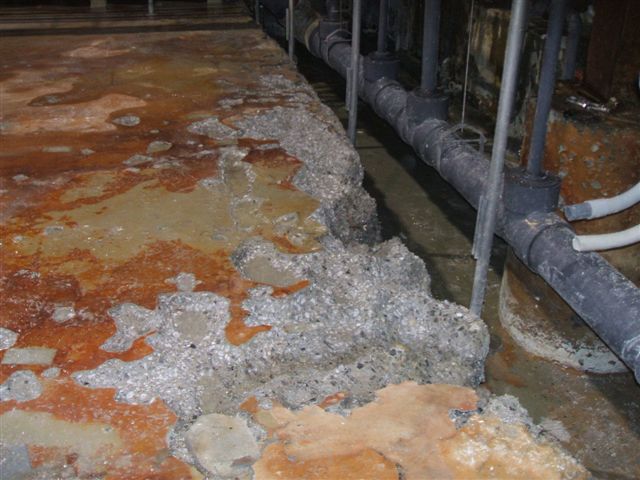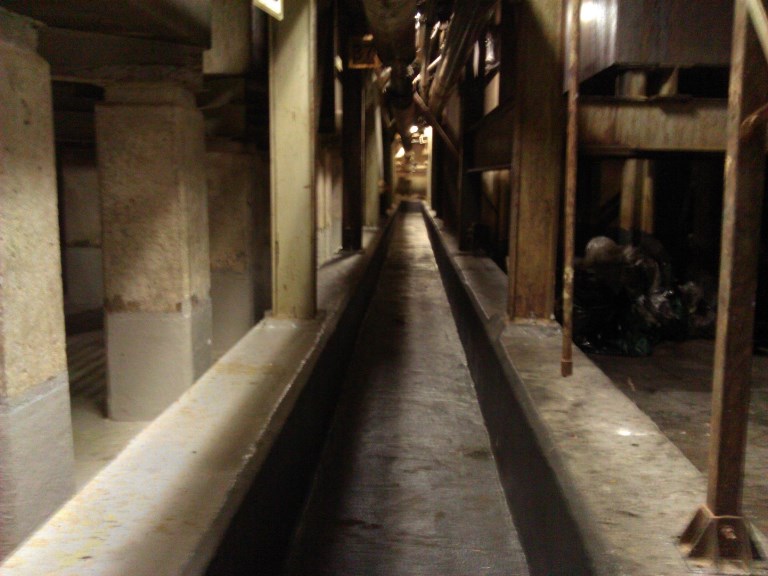Delta Air Lines, Inc., one of the nation’s oldest passenger airlines still operating in the United States today, remains the largest airline carrier by fleet size and passengers — approximately 88 million people — travelling to domestic and international destinations each year. Keeping the airline’s fleet of 725 planes in top shape is priority one for the carrier and is managed through the company’s Technical Operations Centers (TOC). Located at Atlanta’s Hartsfield-Jackson Airport in Georgia, the TOC serves as home base to the airline’s fleet maintenance operations.
It’s at the TOC’s Plating Shop where coatings applicator Benise-Dowling, a U.S. commercial industrial painting and powder coatings contractor of 34 years and long-time preferred contractor of Delta Air Lines for more than 21 years, piloted this secondary containment recoat project. Read on to find out if their project “flight” was able to arrive on time!
Chemical Drips
 The Plating Shop contains 180 acid dip tanks that are up to 15-feet (6 m) deep and filled with various concentrations of chromic, sulfuric, hydrofluoric, hydrochloric, and nitric acid at temperatures as high as 212° F (100° C). Used to clean and etch various landing gear and ancillary equipment, the tanks sit atop a network of concrete pedestals protruding from the solid concrete flooring. Underneath the tanks in the basement are a series of 12 large pre-formed concrete containment moats approximately 90-feet-long (27 m) and 9-feet-wide (3 m) with an 18-inch (46 cm) high curbed wall.
The Plating Shop contains 180 acid dip tanks that are up to 15-feet (6 m) deep and filled with various concentrations of chromic, sulfuric, hydrofluoric, hydrochloric, and nitric acid at temperatures as high as 212° F (100° C). Used to clean and etch various landing gear and ancillary equipment, the tanks sit atop a network of concrete pedestals protruding from the solid concrete flooring. Underneath the tanks in the basement are a series of 12 large pre-formed concrete containment moats approximately 90-feet-long (27 m) and 9-feet-wide (3 m) with an 18-inch (46 cm) high curbed wall.
The moats are designed to catch any spills or drips associated with the chemical baths that the aircraft parts are dipped into during the cleaning and plating process. They were originally lined with large sheets of pre-cut polyvinyl chloride (PVC) plastic that are connected with extrusion welds to provide a barrier against potential chemical corrosion of the concrete substrate beneath. So in May of 2012, when Benise-Dowling was commissioned to conduct a routine maintenance assessment at the Plating Shop hangar, what they found was anything but.
Building Back Up
While walking through the shop’s containment area with a Delta operations manager, the contractor’s executive vice president and co-owner, Curt Dowling, noticed some buckling of the PVC lining inside various areas of the containment moats. He discovered evidence of significant concrete deterioration in several of the floor and wall areas. In some instances, pitting as deep as 3 inches (8 cm) was seen across a 15-square-foot (1 m²) space. In other areas, tank pedestals that had experienced repeated exposure to acids that ran down the sides of the tanks were severely deteriorated. Dowling estimated that nearly 70 percent of the concrete would need repair and re-lining. The repeated exposure to chemical attack was slowly creating gaps between the PVC liner and concrete, thus eroding the containment moat’s infrastructure without detection for an extended period of time.
Once the discovery was made, though, Delta management immediately began investigating alternative methods of rehabilitation and lining options that would help mitigate damages and prevent future occurrences. The chosen solution: the crew would install a direct-bonded mat reinforced lining system, using a novolac vinylester resin and filler powder repair mortar, which would bond directly to the concrete substrate to create a durable, chemical-resistant lining. One bonus of this system was that any potential exposure to chemical attack in the future would be easily identifiable and repaired before any significant damage could occur. In addition, the seamless system would help Delta save on labor and materials costs while providing superior protection. After a brief technical training at Dowling’s warehouse, the 10-person crew was ready to get to work.
The crew began by removing the existing PVC lining by hand. They shoveled the material into buckets, which they then carried to large hazmat drums outside the hangar. Because the containment area was interlaced with a complex maze of piping and ducting, the crew performed all work in a “duck walk” squat throughout the 12-week installation.
 Additionally, because the Plating Shop remained in full operation for the entire duration of the project, initial sections of the already-primed concrete had to be re-cleaned and primed due to chemical drips falling from the tanks above. The crew learned to hang large thick-mil plastic sheeting above work areas to help catch the falling acidic drips and minimize rework.
Additionally, because the Plating Shop remained in full operation for the entire duration of the project, initial sections of the already-primed concrete had to be re-cleaned and primed due to chemical drips falling from the tanks above. The crew learned to hang large thick-mil plastic sheeting above work areas to help catch the falling acidic drips and minimize rework.
Then, crew members used a 5,000-psi (35 MPa) pressure washer to remove all chemical residues. They broom-brushed the concrete with a caustic soda and soda ash rinse to neutralize the pH, and repeated it several times to achieve the desired reading. Once the concrete was cleaned to an equivalent profile of 50-grit sandpaper, or Concrete Surface Profile (CSP) 4, the crew re-poured the vertical walls of the containment moats using a high early mix of concrete: this was used to facilitate more rapid hydration and minimize cure time. Then the crew applied Ceilcote 400 MP, a concrete-based repair mortar for corroded areas that were 1-to-3-inches (3–8 cm) deep. In areas where the depth was less than 1 inch (3 cm) and tapered to a feather edge, the crew used a vinylester mortar mixture to finish out the slope. While working inside the containment moats, the Benise-Dowling crew noticed additional deterioration in the walkway areas between each moat, which also received repairs and linings. After about seven weeks, the repair and cleaning phase was complete.
Next, the crew applied Ceilcote 222GFMR, a reinforced, graphite-filled novolac vinylester lining system. Starting with a Ceilcrete 6650 resin and S-1 powder mixed to a mortar consistency, they trowel-applied the basecoat at 50–60 mils (1,270–1,524 microns). A 1.5-ounce (43 grams) glass mat was then laid into the wet mortar and saturated using Ceilcrete 6650 resin neat (without filler). This process wets out the mat and bonds it directly to the mortar basecoat. The crew had to be careful to eliminate wrinkles, air pockets, and voids during this step. They repeated this procedure in sections until the entire floor and trench of the containment moat was completed.
Once the mat cured enough for foot traffic, the crew ground away any stray fibers, overlap seams, wrinkles, and other imperfections until smooth. The crew followed this by rolling on two finish coats of Ceilcote 222GF Flakeline, a graphite-filled novolac vinylester coating at 12–15 mils (305–381 microns) dry film thickness (DFT) per coat. When dry, the entire system met the specification for the 90-to-120-mil (2,286–3,048 microns) thickness needed for optimum performance.
Flying High
In total, approximately 7,500 square feet (697 m²) of concrete substrate in the containment moats, walkways, and pedestals received repairs and re-lining by August 2012. Dowling claims that the lining system was one of the easiest his installers had ever worked with, which helped contribute to the speed with which the project was completed. Delta managers were equally pleased with the project outcome; the Ceilcote lining system will provide excellent corrosion protection while helping to extend the maintenance life cycle of the Plating Shop’s containment area by nearly 25 years or more. It’s all about what can help to keep their fleet of planes flying high.
